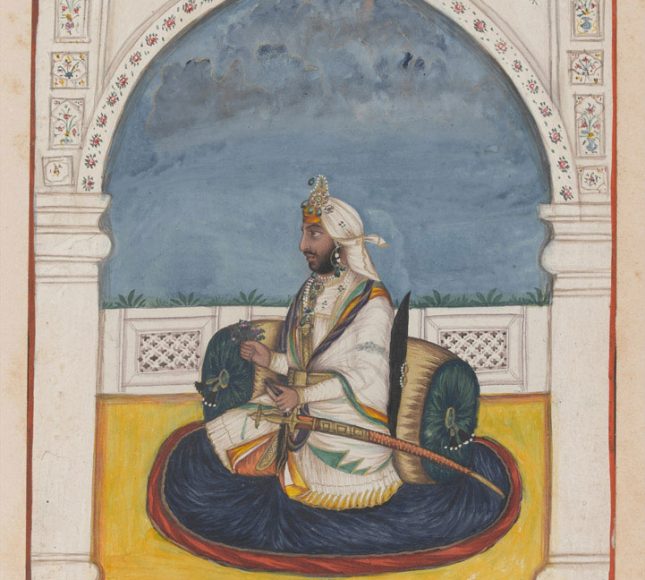SHAMSHER SINGH SANDHANVALIA (1816–1871) was the son of Buddh Singh and a collateral relative of Maharaja Ranjit Singh. Shamsher Singh distinguished himself as a soldier and served on active duty in the Peshawar area. By nature, he was averse to politics and took no part in the courtly intrigues that engulfed Lahore after the death of Maharaja Ranjit Singh. He maintained his position at the Darbar and was appointed a member of the Council of Regency in December 1846.
In February 1848, the Resident at Lahore placed the civil and military establishments in Amritsar under his charge. In 1857, he raised a troop of 125 horsemen, which formed part of Hodson’s Horse. In February 1862, he was given full revenue as well as civil and criminal powers of a deputy commissioner in his own jagir. Shamsher Singh died without issue in 1871.
References:
- Suri, Sohan Lal, Umdat ut-Twarikh. Lahore, 1885–89
- Griffin, Lepel, The Punjab Chiefs. Lahore, 1890
- Chopra, Barkat Rai, Kingdom of the Punjab. Hoshiarpur, 1969
Shamsher Singh Sandhanvalia’s legacy: Soldier to Council Leader, a narrative that illuminates his remarkable journey from courageous military service to influential administrative leadership.
From Battlefield Valor to Stewardship
Shamsher Singh began his career as a dedicated soldier in the service of the Sikh state. Noted for his active duty in the Peshawar area, he distinguished himself through his discipline and commitment on the battlefield. His martial exploits not only earned him respect but also laid the groundwork for a reputation as a reliable and effective leader. Despite the turbulence that often accompanies military engagement, Shamsher Singh maintained a clear focus on duty—a focus that later proved instrumental in his transition to roles of governance.
A Stand Against Courtly Intrigue
Unlike many of his contemporaries who became entangled in the intricate politics that marked the post-Ranjit Singh court, Shamsher Singh was by nature averse to such intrigues. His decision to avoid the often treacherous paths of factional politics allowed him to maintain an unblemished record of service. This impartiality and commitment to duty were deeply valued at the Darbar, where his steady character earned him a place on the Council of Regency in December 1846. His approach exemplified an ethos that placed public service above personal ambition—an ethos that continues to resonate as a model of leadership.
Administrative Acumen and Expanded Responsibilities
The trust placed in Shamsher Singh extended well beyond his early military contributions. In February 1848, the Resident at Lahore recognized his adeptness by entrusting him with the civil and military establishments in Amritsar. This pivotal assignment not only underscored his administrative competence but also highlighted the transitional nature of the period—when local governance had to adapt to larger imperial influences while retaining indigenous traditions of authority.
During the tumult of 1857—a year that redefined the political landscape in the region—Shamsher Singh once again proved his mettle by raising a troop of 125 horsemen, later incorporated into Hodson’s Horse. This act of leadership, amid considerable uncertainty, further solidified his reputation as a resilient and resourceful officer.
By February 1862, his credentials had grown to such an extent that he was granted full revenue as well as civil and criminal powers of a deputy commissioner over his own jagir. This culmination of military valor and administrative expertise exemplified his evolution from a battlefield commander to an effective council leader—one entrusted not only with the defense of his state but also with the governance of its people.
Enduring Legacy
Shamsher Singh Sandhanvalia’s legacy is multifaceted:
- A Paragon of Duty and Impartiality:
His avoidance of courtly politics, alongside his dedication to service, exemplifies a leadership style that values duty over personal gain. This impartiality and forthrightness allowed him to navigate a period marked by both internal upheaval and external pressures. - Architect of Transitional Governance:
As the political landscape shifted after Maharaja Ranjit Singh’s death, Shamsher Singh played a crucial role in bridging the gap between the old order and the emerging administrative structures influenced by colonial oversight. His appointments—from the Council of Regency to commanding the civil apparatus in Amritsar—reflect the trust placed in him during a time of change. - A Symbol of Service in a Complex Era:
His legacy, though ultimately cut short by his death without issue in 1871, offers enduring lessons in leadership. The synthesis of martial prowess and administrative acumen in his career serves as a historical beacon for balancing duty, integrity, and effective governance even in challenging circumstances. Reflecting on the Impact
Shamsher Singh’s journey from the battlefield to the high echelons of state administration illustrates the dynamic nature of leadership in 19th-century Punjab. His steadfast character and measured approach allowed him to safeguard the interests of his state while adapting to the shifting realities of a post-Ranjit Singh era. His life reminds us that true leadership often requires setting aside personal ambition in favor of the greater good—an ideal that continues to inspire contemporary discussions on public service and governance.



